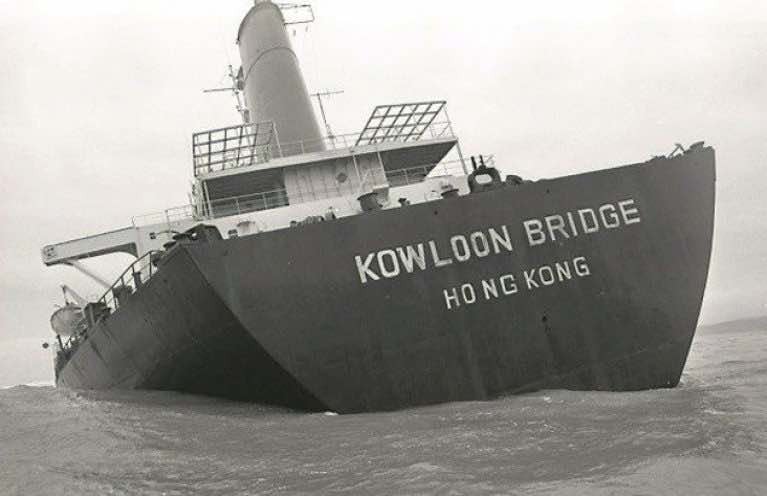Displaying items by tag: Kowloon Bridge
Baltimore Thoughts: The Beacon, The Kowloon Bridge & Richard Bushe
The Beacon at Baltimore can be a miserable place. It's nice to see on a good Summer's day sailing by and bound for the harbour entrance, but it's different in nasty weather.
That's what I had remembered this past week - the time when an enormous vessel, 900 feet long, threatened to become a huge plug blocking that entrance.
It was around 1 a.m. on a rotten late November morning in 1986, dark, cold, wet, howling gale to brace oneself against "up at the Beacon", watching the abandoned, powerless Kowloon Bridge, driven by the power of a huge gale, towards Baltimore. She had been sheltering in Bantry Bay after damage sustained in another gale while crossing the Atlantic. She wasn't a lucky ship. Anchoring failed and, in fear of hitting another very large tanker, the Capo Emma, also sheltering in the Bay and with 80,000 tonnes of crude oil aboard, the Indian officers in charge decided to put to sea – into winds reported at 70 miles an hour, seas over 40 feet high.
 The Beacon at Baltimore Harbour on the West Cork coast Photo: W M Nixon
The Beacon at Baltimore Harbour on the West Cork coast Photo: W M Nixon
With no luck at all, her steering failed, and the crew of 27 were rescued by RAF Sea King helicopters from the Royal Naval Air Station at Culdrose in Cornwall, then providing rescue cover in Irish waters.
I was one of the crowds of reporters, cameramen and local people that morning at the Beacon, watching the ghostly shape of the ship, seeming to be swinging towards the entrance to the West Cork Harbour. The local view was that, if it hit rocks there, Baltimore could be blocked for a long time!
Mercifully it didn't, the seas headed it eastwards, and she grounded on the Stags from where the Dutch salvage company, Smith Tak, couldn't shift it. In a few months, the seas on the West Cork coastline did that work. The Kowloon Bridge disappeared beneath the waves, worn away by its futile battle against the elements of Nature.
I recalled that in the past week when I heard of the death of a man whom I knew for many years and was one of those concerned about the Kowloon Bridge that morning. He was Richard Bushe, who died at the age of 91 died at his appropriately maritime-named home - The Cove Baltimore. His village pub, still run by the family, is one of the most well-known maritime locations in Ireland and to visitors from overseas, the place to which every sailor visiting Baltimore called. He was one of the strongest supporters of Baltimore Sailing Club since its inception in the early 1950s.
 Richard Bushe - a strong supporter of Baltimore Sailing Club
Richard Bushe - a strong supporter of Baltimore Sailing Club
As Charlie Bolger, Commodore of Baltimore Sailing Club wrote on the club's website: "You won't find his name amongst the list of Commodores, but Richard Bushe quietly contributed support to every Commodore with his sound advice and wisdom over the past sixty years. He was the go-to person for sailors seeking local knowledge on any topic."
Bushe's Bar has always been to me like a little maritime museum; there is so much of the lore of the sea there – maps, artefacts, items contributed by visiting and local sailors over many years. It is the go-to-place when one is in Baltimore, a place of many memories, of which Richard Bushe was certainly one.
Looking back to those days of the Kowloon Bridge, when the media centred itself at Baltimore as the story of environmental damage and pollution was reported, I also think how unprotected our waters and coastline were, how the State didn't seem to get any adequate compensation for the damage caused, there was no inquiry and Cork County Council, and its ratepayers wound up with most of the cost of €500,000. And, most of all, looking at pictures of that huge vessel, how the power of the sea at the Stags did what human endeavour couldn't do and removed that massive 900-foot vessel from sight. Today it's cargo of 160,000 tonnes of iron ore pellets, said to have been insured for stg£2.7m., still lies on the seabed.
Listen to the Podcast here.
Lecture: 'The Kowloon Bridge & Her Sisters'
The Stella Maris Seafarers' Club, Beresford Place, is located beside Busaras and faces opposite the rear of the Customs House. Nearby is the Irish Life Center (ILAC) which is convenient for car-parking and buses, the 'Red' Luas (Busaras stop) and DART stops at Connolly /Tara St. stations. All are welcome, bar and refreshments and a voluntary contribution is appreciated.
For further information about lectures and updates on the M.I.I's maritime museum located in the Mariners Church, Dun Laoghaire log on to www.mariner.ie. The museum which is due to reopen this year are looking for volunteers to help, for further details click here.






























































